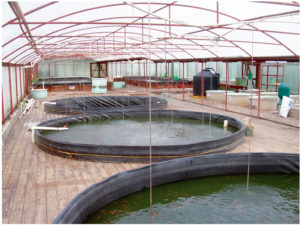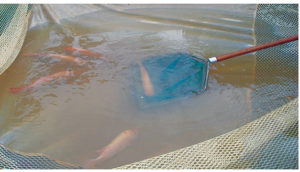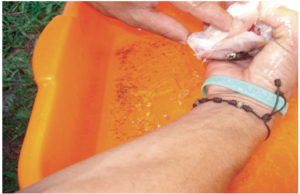Structures help maintain water temperature

Fingerling production for profit has expanded in the Central American region during the past 15 years, in large part due to the success of several prominent commercial operations that export fresh fillets to markets in North America. Sales of mostly whole gutted and scaled fish or live fish in Central American markets have increased dramatically with the rise in the volume and value of the exported products.
Most of Central America has a warm climate. At locations in the interiors of these countries, elevation has a strong indirect effect on local temperature regimes. Since tilapia are tropical fish, their optimal growth is generally observed at water temperatures in the 25 to 30 degrees-C range. Water temperatures for commercial tilapia production should remain in this range year-round.
Seasonal changes in temperature can negatively impact the growth rate and reproductive performance of tilapia. Similar to marine shrimp farming in this region, tilapia growth is reduced during the dry season, which includes December, January and February – months when local water temperatures are below the optimal range.
At the author’s station in Honduras, which is at about 14 degrees North latitude and 750 meters above sea level, 18 to 20 degrees-C water temperatures are often observed in production ponds during the months of December and January. At these temperatures, tilapia reproduction and growth are greatly reduced or cease altogether. An important detail is that there are few clouds and brilliant sunlight on most days comprising the dry season. Therefore, ambient temperatures are reduced, but there is an abundance of sunlight in this part of each year.
Seedstock limitations
One factor that tends to limit the further development of tilapia culture for local markets is the continued lack of adequate seed for stocking production ponds. Locally produced and distributed seed is often available only during part of each year. It is generally not of consistent quality in regards to uniformity of size and color of the fish. Importantly, each lot should contain over 97 percent male fingerlings for stocking, which is critical for success in the fattening stage of production. Most tilapia fingerling producers in this region use the methyl testosterone sex-reversal procedure.
In a study done several years ago, the author’s research group found that red tilapia fingerlings purchased from 16 different suppliers in Honduras included an average of only 85 percent male fish with a range of 43 to 98 percent. Additionally, these producers did not have fingerlings available for sale during most of the dry season of each year due to local temperatures and the resulting poor reproductive activity of the adult fish. The study will be repeated in 2010 to evaluate progress in this important sector of the tilapia industry.
Water temperature control

At Zamorano, a private international university whose programs respond to the environmental and social challenges facing Latin America, tilapia fry are typically produced for sex reversal in concrete tanks or production ponds of 200 square meters or smaller area. The broodfish are stocked in the tanks or ponds, and free-swimming fry are collected every other day for grading and sex reversal.
To begin to control water temperatures, the author’s group started in 2000 to cover tanks with translucent plastic film to provide a “greenhouse” effect. After 24 hours with continuous aeration during the dry season, the water in tanks covered with plastic was about 1 degree-C warmer than that in uncovered tanks. This difference increased to about 3 degrees-C after seven days. The plastic film trapped heat during the daylight hours and retarded heat loss during the nighttime. It also protected the fish from avian predators.
Since tilapia reproduction can be done with intensive management protocols, Zamorano constructed a greenhouse structure to provide passive temperature control for maintaining adult fish under adequate conditions for year-round reproduction – and fingerling sales. Greenhouse structures were also used over two small production ponds for tilapia reproduction. In 2007, the author implemented more-intensive management of red tilapia broodfish in hapas placed in 15-square-meter concrete tanks covered with plastic film and aerated continuously.
Eggs and newly hatched sac-fry are harvested from the oral cavities of incubating females in each hapa at seven- to 10-day intervals. The offspring are artificially incubated and then sex reversed with methyl testosterone. The procedure allows careful monitoring of fry development so that hormone treatment commences with fry of 9- to 10-mm total length to ensure excellent results in sex reversal (±98 percent) and a more uniform fingerling size for sale to fish farmers.
Improved production

By commencing sex reversal with fry of this size, the number of hormone treatment days and production costs can be reduced. The technique is labor intensive, but after just several weeks, survival rates of 80 percent and greater were attained in the incubation system.
The removal and artificial incubation of offspring from females’ mouths resulted in a 400 percent increase in fry production compared to the alternate day capture of free-swimming fry from similar production units. The intensive management of tilapia broodstock in hapas and the artificial incubation of eggs and sac-fry combine in an effective procedure that can result in increased production and significant cost savings for fingerling producers.
Editor’s Note: To promote the distribution of more and better tilapia seed for Central American fish famers, the Zamorano University website at www.acuacultura.org includes several documents in Spanish on the fundamentals of tilapia biology and culture. The school also offers technical training.
(Editor’s Note: This article was originally published in the September/October 2009 print edition of the Global Aquaculture Advocate.)
Now that you've finished reading the article ...
… we hope you’ll consider supporting our mission to document the evolution of the global aquaculture industry and share our vast network of contributors’ expansive knowledge every week.
By becoming a Global Seafood Alliance member, you’re ensuring that all of the pre-competitive work we do through member benefits, resources and events can continue. Individual membership costs just $50 a year. GSA individual and corporate members receive complimentary access to a series of GOAL virtual events beginning in April. Join now.
Not a GSA member? Join us.
Author
-
Daniel E. Meyer, Ph.D.
Escuela Agrícola Panamericana
“Zamorano”
Apartado Postal No. 93
Tegucigalpa, Honduras
Related Posts

Health & Welfare
10 paths to low productivity and profitability with tilapia in sub-Saharan Africa
Tilapia culture in sub-Saharan Africa suffers from low productivity and profitability. A comprehensive management approach is needed to address the root causes.

Health & Welfare
A look at tilapia aquaculture in Ghana
Aquaculture in Ghana has overcome its historic fits and starts and is helping to narrow the gap between domestic seafood production and consumption. Production is based on Nile tilapia.

Health & Welfare
Advice for managing predatory birds, part 1
Predatory birds can cause major losses for tilapia farms. As some bird species are protected by law, fish farmers must use non-lethal control techniques.

Responsibility
Aquaculture effluent partially replaces growing mix for plant production
Aquaculture effluent can be an effective fertilizer in land-based plant production. Research with tilapia utilized dewatered aquaculture effluent (A.E.) as a partial substrate replacement for tomato plant seedlings. Seedling growth decreased when effluent replaced a commercial growing mix at 25 percent or more.


